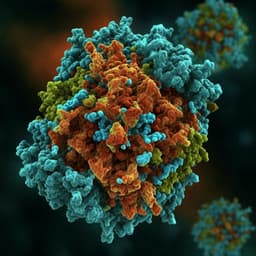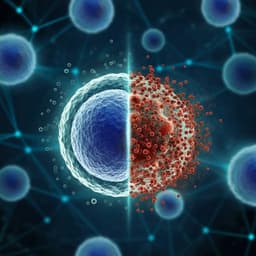
Health and Fitness
Nrf2 epigenetic derepression induced by running exercise protects against osteoporosis
X. Chen, X. Zhu, et al.
This groundbreaking study by Xingren Chen, Xiaobo Zhu, Ai Wei, Fang Chen, Qi Gao, Ke Lu, Qing Jiang, and Wangsen Cao uncovers how running exercise may safeguard against osteoporosis through epigenetic mechanisms. Discover how the Nrf2 gene plays a crucial role in maintaining bone density and how exercise can reverse damaging methylation effects in osteoporotic conditions.
~3 min • Beginner • English
Introduction
Osteoporosis (OP) is a progressive skeletal disease with low bone mineral density (BMD) and compromised trabecular microstructure resulting from an imbalance favoring osteoclastogenesis over osteoblastogenesis. Its pathogenesis involves aging, mechanical loading, mineral and hormone metabolism abnormalities, and various stresses that alter osteogenic gene transcription. Emerging evidence implicates epigenetic regulation, particularly DNA methylation, in controlling osteoclastogenesis and osteoblastogenesis, with numerous CpG methylation changes identified in trabeculae of OP patients. DNA methylation is catalyzed by DNMT1 (maintenance) and DNMT3a/3b (de novo) and can be reversed via TET-mediated demethylation. While demethylating drugs show benefits in animal OP models, long-term use has side effects. Physical exercise beneficially modulates DNA methylation in diverse conditions and is known to support bone health, but whether its antiosteoporotic effects are epigenetically mediated is unclear. Oxidative stress contributes to OP risk; Nrf2, a master antioxidant transcription factor, maintains bone homeostasis by inducing antioxidant enzymes (catalase, SOD, GPX). Nrf2 deficiency increases OP susceptibility in mice, and Nrf2 activation is protective. Nrf2 promoters contain CpG islands and are epigenetically downregulated in aging-related diseases, suggesting that epigenetic Nrf2 suppression may drive OP. This study tests whether running exercise (RE) confers osteoprotection via epigenetic derepression of Nrf2 in ovariectomy-induced OP.
Literature Review
- OP results from an imbalance between osteoclast-mediated resorption and osteoblast-mediated formation; histologically, it features reduced BMD and deteriorated trabeculae. Prior work highlights roles of aging, mechanical stimuli, and metabolic/hormonal factors.
- Epigenetics in OP: DNA methylation alterations at multiple loci (e.g., ALPL, SOST, RANKL/OPG, Wnt pathway genes) have been associated with osteopenia/OP, though causality is uncertain. Demethylating agents like decitabine can attenuate osteoclastogenesis and improve BMD in animal models; DNMT1 and DNMT3b upregulation has been reported in disuse and unloading OP models, and selective inhibition can mitigate bone loss.
- Exercise and epigenetics: Exercise can remodel promoter methylation and reprogram the epigenome in muscle and adipose tissue; it is effective for preserving bone density in postmenopausal women. The potential epigenetic mechanism underlying exercise’s osteoprotection remains to be defined.
- Nrf2 in bone: Nrf2 regulates antioxidant defenses (SOD, catalase, GPX) and supports bone acquisition; its deficiency exacerbates OP, whereas pharmacologic activation is protective. The Nrf2 promoter has CpG islands and is downregulated by methylation in aging-related conditions, implying a possible role of epigenetic suppression in OP.
Methodology
- Study design: Experimental mouse model of osteoporosis (ovariectomy, Ovx) with and without running exercise (RE), including Nrf2 knockout (Nfe2l2-/-) and wild-type (WT) littermates. Human femoral samples from osteoporotic and non-osteoporotic patients were analyzed for comparison.
- Animals: Female ICR mice (10–12 weeks), Nrf2 knockout mice (Nfe2l2-/-) and WT littermates. Groups: (I) Sham, (II) RE, (III) Ovx, (IV) RE/Ovx; at least 6 mice per group. Ovx performed under isoflurane anesthesia with bilateral ovary removal; sham had identical surgery without ovary removal. After 1 week recovery, RE groups underwent treadmill running at 10 m/min for 1 hour daily for 4 weeks. Additional cohorts included young (3 months) and old (25 months) male ICR mice for age comparison of femoral Nrf2 expression.
- Human samples: Femurs from joint replacement surgeries. OP defined as T score ≤ -2.5; controls T score ≥ -1. OP group: 4 female patients (68–75 years), mean T score -3.49; controls: 3 patients (49–71 years), mean T score -0.67. Samples stored at -80 °C.
- Micro-CT: Left femurs fixed in 4% paraformaldehyde. Scanned with Scanco micro-CT (55 kV, 145 µA, 15.6 µm voxel, 250 ms). Regions: distal metaphysis (100 slices, 780 µm from growth plate) and mid-diaphysis (50 slices). Outcomes: BMD (mg·ccm⁻¹ HA), BV/TV, Tb.N, Tb.Th, Tb.Sp, cortical thickness (Ct.Th), and trabeculae/total sectional area.
- Histology/IHC: H&E, TRAP staining, and IHC for Nrf2, DNMT1, DNMT3a, DNMT3b, osteocalcin on human and mouse femoral sections using standard protocols and DAB visualization.
- Western blotting: Femoral homogenates probed for Nrf2, Runx2, TRAP, catalase, DNMT1, collagen I, DNMT3a, DNMT3b, osteocalcin, SOD2, with β-actin or GAPDH controls; ECL detection; ImageJ quantification.
- DNA methylation assays: CpG island analysis and MSP/BSP primer design via MethPrimer. MSP on human and mouse femoral genomic DNA with methylated/unmethylated primer sets and input controls; agarose gel and densitometry quantification as methylated or unmethylated PCR over total after input normalization. BSP on mouse Nrf2 promoter: bisulfite-treated DNA amplified (covering same CpG island as MSP), cloned (pGEM-T Easy), five clones sequenced per sample; methylated cytosines calculated as percent of total cytosines.
- Antioxidant enzyme activities: GPX and total SOD in femoral homogenates measured with commercial kits; GPX via NADPH consumption at 340 nm; SOD via formazan dye at 450 nm. Reported as relative fold changes.
- Statistics: Normality (Shapiro–Wilk) and homogeneity (Levene). One-, two-, or three-way ANOVA as appropriate with Tukey’s post hoc tests. Data presented as mean ± SEM; significance P < 0.05.
- Sample sizes: Unless specified, n = 6 mice per group; for human protein analyses, 3 controls and 4 OP patients. For MSP/BSP, representative subsets sequenced as described.
- Exercise protocol: 1 hour per day treadmill running at 10 m/min for 4 weeks following 1-week post-surgical recovery.
Key Findings
- Nrf2 deficiency exacerbates OP after ovariectomy: Nfe2l2-/- mice showed more severe trabecular loss and micro-CT abnormalities than WT after Ovx, including worse BMD, BV/TV, Tb.N, Tb.Th, and increased Tb.Sp. Trabe/Total area ratio: WT sham 0.292 ± 0.006; Nfe2l2-/- sham 0.281 ± 0.009; WT Ovx 0.192 ± 0.012; Nfe2l2-/- Ovx 0.116 ± 0.012 (P < 0.05 for Ovx vs respective sham and Nfe2l2-/- Ovx vs WT Ovx).
- Nrf2 suppression in OP: Femoral Nrf2 and collagen I protein levels were reduced in human OP patients (n=4), aged mice (25 months), and Ovx mice compared with controls; IHC confirmed reduced Nrf2 in Ovx femurs.
- Nrf2 promoter hypermethylation in OP: MSP revealed increased Nrf2 promoter methylation in OP femurs versus controls (humans: 74.4% ± 3.76% vs 21.9% ± 3.6%; mice: 73.8% ± 2.73% vs 19.5% ± 2.9%; P < 0.05). DNMT1, DNMT3a, and DNMT3b were upregulated in both human OP and Ovx mouse femurs (WB and IHC).
- Running exercise demethylates Nrf2 promoter and reduces DNMTs: In Ovx mice, Nrf2 promoter methylation increased (MSP 78.38% ± 3% vs 22.83% ± 2.05% in sham); RE reduced methylation to 28.68% ± 5.3% (P < 0.05). BSP showed CpG methylation increased from 10% ± 0.85% (sham) to 30% ± 2.14% (Ovx) and decreased to 14.07% ± 0.57% with RE (P < 0.05). RE mitigated elevations of DNMT1/3a/3b.
- Running exercise protects bone microarchitecture and restores osteogenic markers: RE improved BMD, BV/TV, Tb.N, Tb.Th, reduced Tb.Sp, and increased Ct.Th in Ovx mice. RE restored Nrf2, collagen I, Runx2, osteocalcin and reduced osteoclast marker TRAP in Ovx femurs (WB and IHC).
- Antioxidant enzymes downstream of Nrf2: Catalase and SOD2 proteins were reduced in human OP and Ovx mice; RE alleviated these reductions. GPX and total SOD enzymatic activities were decreased in Ovx femurs (P < 0.05) and improved with RE (P < 0.05).
- Nrf2 is essential for RE benefits: In WT mice, RE significantly improved micro-CT parameters and normalized molecular markers; in Nfe2l2-/- mice, RE’s protective effects were largely abolished. Three-way ANOVA for BMD indicated significant effects of genotype (P1 < 0.00001), RE (P2 = 0.00221), and genotype × RE interaction (P3 = 0.02765). Molecular and enzyme activity improvements with RE were diminished in Nfe2l2-/- mice.
Discussion
The study demonstrates that Nrf2 repression is a characteristic epigenetic feature of osteoporosis and that elevated DNMT1/3a/3b contribute to Nrf2 promoter hypermethylation and reduced expression. Running exercise reverses these epigenetic abnormalities by reducing DNMT levels, demethylating the Nrf2 promoter, and restoring Nrf2 expression. This derepression reactivates downstream antioxidant defenses (catalase, SOD2, GPX), reduces oxidative stress, and beneficially modulates osteoblastogenesis and osteoclastogenesis markers (Runx2, osteocalcin, TRAP), culminating in improved BMD and trabecular/cortical microarchitecture in Ovx mice. The diminished benefits of RE in Nfe2l2-/- mice establish Nrf2 as essential for the osteoprotective effects of exercise. These findings bridge the known osteogenic effects of mechanical loading with an epigenetic mechanism and suggest that individuals with epigenetically suppressed Nrf2 due to environmental exposures may be at heightened OP risk but could benefit from exercise-driven epigenetic modulation.
Conclusion
Nrf2 repression driven by elevated DNMT1/3a/3b and promoter hypermethylation contributes significantly to OP pathogenesis in mice and is observed in human OP femurs. Running exercise effectively reduces DNMT expression, demethylates the Nrf2 promoter, restores Nrf2 and its antioxidant targets, and protects against Ovx-induced bone loss and microarchitectural deterioration in a largely Nrf2-dependent manner. These results identify Nrf2 as a key epigenetic node linking exercise to osteoprotection and suggest potential clinical strategies leveraging physical activity to modulate epigenetic states in OP. Future work should determine upstream triggers of DNMT elevation in OP, validate these mechanisms in larger human cohorts, assess dose-response and modality effects (e.g., combined weight-bearing and resistance training), and explore potential synergism with pharmacologic epigenetic or Nrf2-targeted interventions.
Limitations
- Translational scope: Primary mechanistic evidence derives from a mouse Ovx model; human data are limited to small cross-sectional femoral samples (n=4 OP, n=3 controls), which may limit generalizability.
- Exercise modality and dose: Only one aerobic treadmill protocol (10 m/min, 1 h/day for 4 weeks) was tested; other modalities, intensities, and durations were not evaluated.
- Causality of upstream events: While DNMT elevations associate with Nrf2 hypermethylation, upstream signals driving DNMT upregulation in OP remain undefined.
- Cell-type specificity: Analyses were performed on whole femoral tissues; cell-specific epigenetic and transcriptional changes in osteoblasts, osteoclasts, and osteocytes were not dissected.
- Potential inconsistencies: Some reported statistical descriptions (e.g., non-significant differences with P < 0.05) may reflect typographical issues and warrant cautious interpretation.
Related Publications
Explore these studies to deepen your understanding of the subject.







